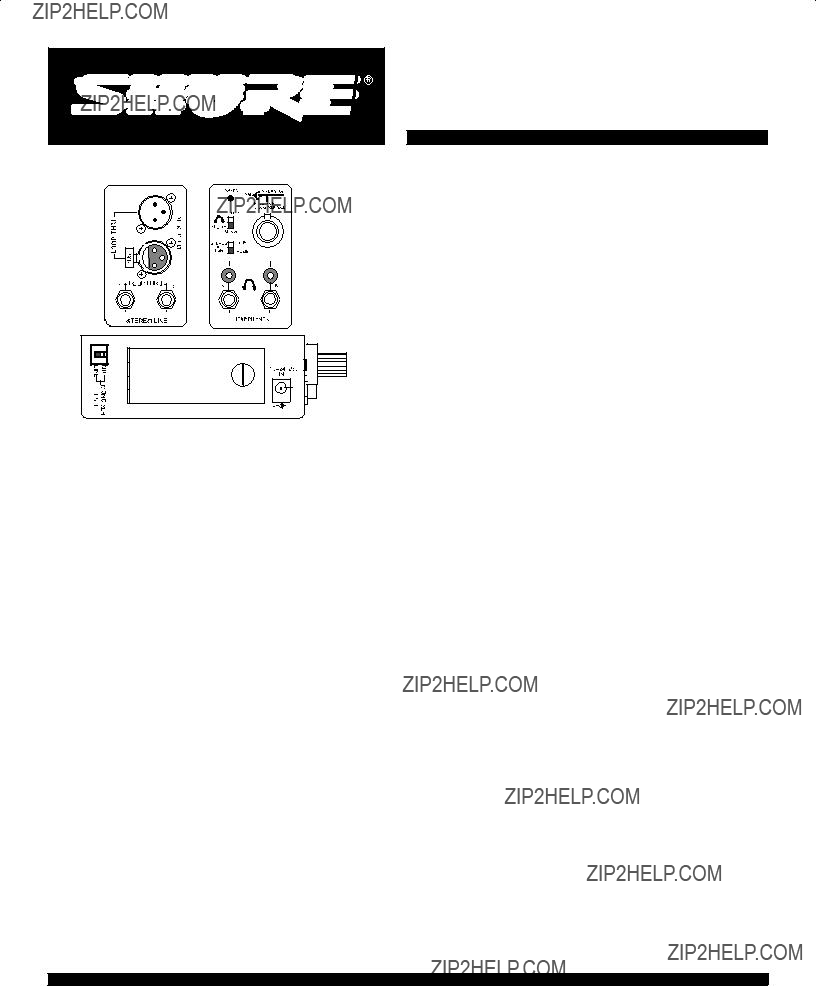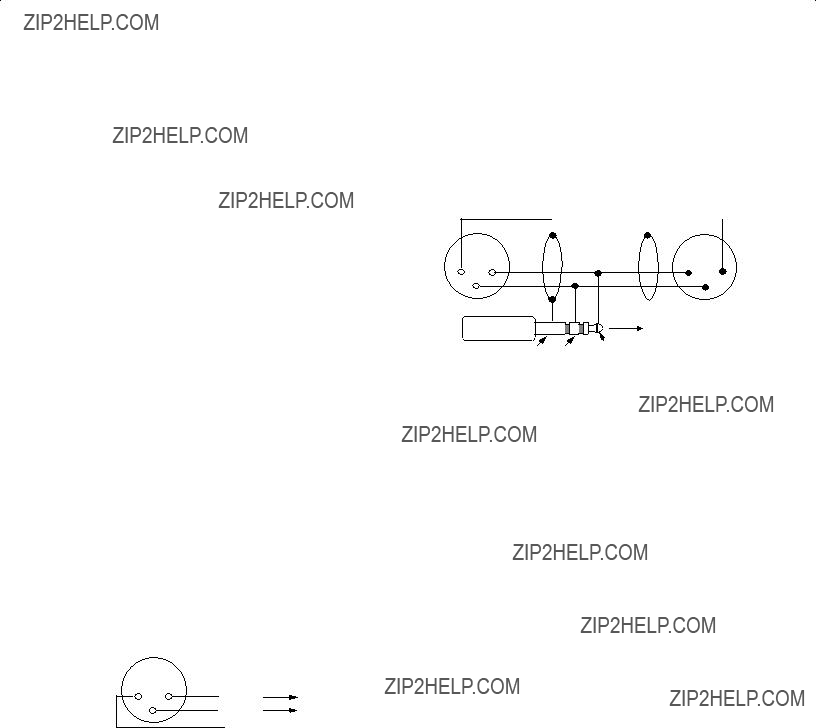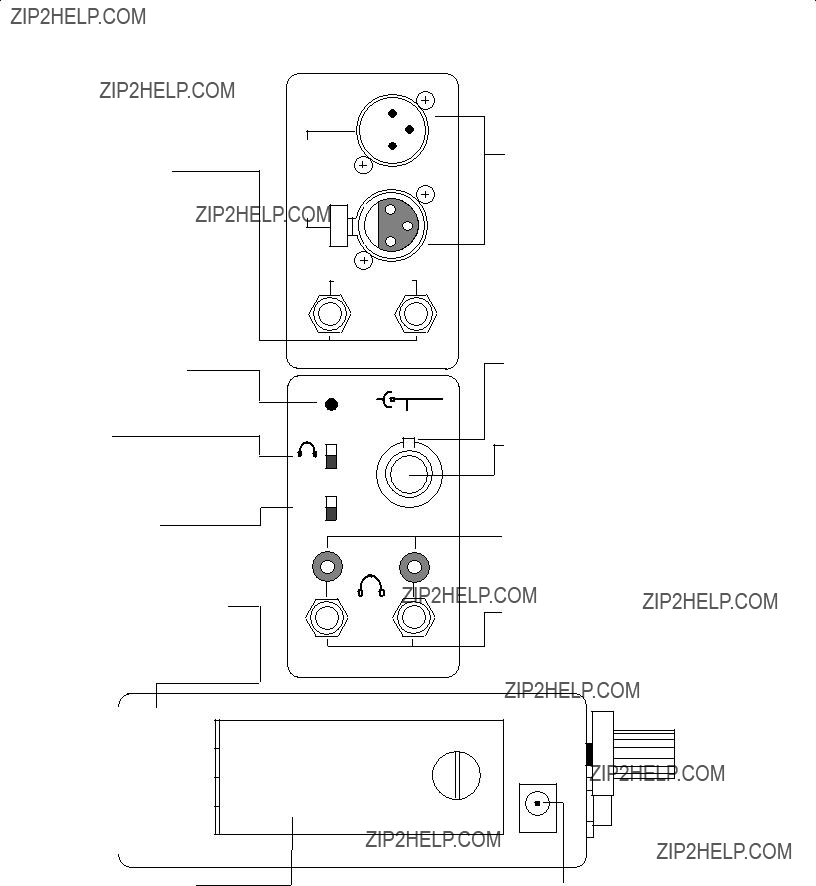Phase
Input in phase with output. Pin 2 of XLR input in phase with tip and ring of all Headphones jacks.
Power
Internal . . . . . . . . . . . . . . . . . . . . . . . One 9 V alkaline battery Battery Life . . . . . . . . . Approximately 15 hours under normal operating conditions External . . . . . . . . . . . . . . . . . . . . . . . . . . . . . . . . 12 to 24 Vdc
Current drain (typical) . . . . . . . . . . . . . . . 11 mAdc; 80 mAdc (clipping) at 9 Vdc
Connectors
Loopthrough
Two 3-pin balanced XLR-type connectors (one male, one fe- male)
Two 1/4-inch stereo phone jack (tip-left; ring-right; sleeve-
ground) Headphones
Two 1/4-inch stereo phone jack headphone outputs Two 3.5 mm stereo mini jacks
Power
6.5 mm coaxial power connector (tip +, sleeve ??)
Case
Die-cast zinc; matte black enamel finish
Overall Dimensions
80.9 mm H x 55.5 mm W x 153 mm D (3-3/16 x 2-3/16 x 6-1/16 in.)
Net Weight
450 grams (1 lb)
NOTE: The FP22 is lightweight and can be clipped to a belt or trousertop, or to D-rings on other equipment. The FP22 belt clip is attached to the case with two easily removable screws. The FP22 will stand on a flat surface, and several units can be stacked together with their belt clips removed.
SETUP
Battery Replacement
1.Use a coin or screwdriver to turn the 1/4-turn lockscrew fasten- er in either direction to open the battery compartment door.
2.Insert a fresh 9??volt alkaline battery (NEDA 1604A, Duracell MN1604A, Eveready 522, or equivalent) in the compartment. The battery compartment is designed so that the polarized bat- tery terminals cannot be inserted incorrectly. Plated spring ter- minals ensure solid electrical contacts.
External Power
The coaxial dc power jack accepts a dc voltage from 12 to 24 volts. External dc power feeds a regulator to power the FP22 cir- cuitry. The dc input jack is directly compatible with Shure Model PS20 or PS20E Power Supplies. The tip of the coaxial jack is positive (+), the sleeve is negative (??). A coaxial power plug in- serted into the external power jack disables the internal battery power.
Signal Connections
Mono XLR??Microphone?? or line??level signals
1.Set the Mono XLR Mic-Line switch to the appropriate signal level.
2.Connect a balanced microphone or line level signal to either Mono XLR jack.
3.If loopthrough is desired, use the unused XLR connector as an output.
NOTE: No damage will result if the Mic-Line switch is set incorrectly. However, objectionable distortion may result if line level signals are monitored with the switch in the Mic position.
Stereo Line??Line?? or Aux??level signals only
1.Connect a 1/4-inch stereo connector to either Stereo Line jack.
2.If loopthrough is desired, use the unused 1/4-in. stereo con- nector as an output.
3.Set the front panel Stereo Line Pad to the 0 dBm line??level signal position. The ??30 dB position is used when the FP22 line??level input signals are +4 dBm or greater.
NOTE: As explained in the Internal Switches description, the FP22 can accept left and right input signals on separate con- nectors. Stereo Line jack (1) is left, Stereo Line jack (2) is right.
Headphones
1. Connect headphones to the Headphones A and B jacks. NOTE: Each pair of Headphones jacks consists of one 1/4-inch
and one 3.5 mm stereo connector. Only one connector of each pair can be used at one time. Plugging into the 1/4-inch connector disconnects its associated 3.5 mm connector.
OPERATION
NOTE: A simplified block diagram on the side of the FP22 pro- vides a quick reference to its functional circuitry.
1. Rotate the overall Volume control clockwise to power the FP22. The Power LED indicator lights to show that the unit is on. Turn the level control carefully to avoid excessive head- phone levels. The Volume control adjusts both the Mono XLR signal and Stereo Line signal.
WARNING
The FP22 can produce ear??damaging headphone levels. Turn the headphones Volume control up slowly when making adjustments.
2.Pull out the Volume control knob and rotate clockwise to in- crease the volume level of the Mono XLR signal only. This ad- justment will not affect the overall volume. A center detent posi- tion provides a starting volume level for the Mono XLR signal.
3.Rotate the Balance control left or right to control the overall left/ right signal balance.
4.If mono monitoring is desirable, set the Stereo/Mono switch to Mono.
INTERNAL SWITCHES
Two switches are located inside the FP22. These control the signal path through the unit. The switches are located on the ver- tically mounted printed circuit board inside the unit adjacent to the Loopthrough phone jacks. To access the switches, remove the three Phillips-head screws on the side panel of the unit.
Internal Switch S-104 consists of two independent single- pole, single??throw switches controlling the path of the Mono XLR input signal:
1.When S104-1 and -2 are in the On position, the Mono XLR sig- nal is routed to both left and right earphones.
2.When S104-1 is in the On position and S104-2 is in the Off position, the Mono XLR signal goes to the left channel.
3.When S104-1 is in the Off position and S104-2 is in the On position, the Mono XLR signal goes only to the right channel.
4.If both S104-1 and -2 are in the Off position, NO signal from the Mono XLR input appears at the headphone outputs.
Internal Switch S105 is a two??position slide switch that
changes the Stereo Line jacks from Loopthrough TRS stereo in- puts to separate left and right mono inputs.
1. When internal switch S105 is set for stereo, the Stereo Line jacks accept a stereo signal on a single 1/4-inch stereo connector (tip- left; ring-right; sleeve-ground). This allows for a loopthrough of a



 REF
REF


